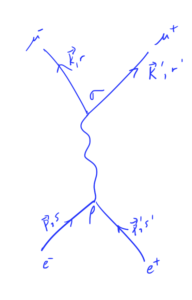I’ve now uploaded a new version of my class notes for PHY2403, the UofT Quantum Field Theory I course, taught this year by Prof. Erich Poppitz.
This update adds notes for all remaining lectures (up to and including lecture 23.) I’ve made a pass with a spellchecker to correct some of the aggregious spelling erorss, and also redrawn three figures, replacing photos, which cuts the size in half!
I’ve posted the redacted version (316 pages). The full version, with my problem set solutions (including errors) is 409 pages.
Feel free to contact me for the complete version (i.e. including my problem set solutions, with errors) of any of these notes, provided you are not asking because you are taking or planning to take this course.
Contents:
- Preface
- Contents
- List of Figures
- 1 Fields, units, and scales.
- 1.1 What is a field?
- 1.2 Scales.
- 1.2.1 Bohr radius.
- 1.2.2 Compton wavelength.
- 1.2.3 Relations.
- 1.3 Natural units.
- 1.4 Gravity.
- 1.5 Cross section.
- 1.6 Problems.
- 2 Lorentz transformations.
- 2.1 Lorentz transformations.
- 2.2 Determinant of Lorentz transformations.
- 2.3 Problems.
- 3 Classical field theory.
- 3.1 Field theory.
- 3.2 Actions.
- 3.3 Principles determining the form of the action.
- 3.4 Principles (cont.)
- 3.4.1 d = 2.
- 3.4.2 d = 3.
- 3.4.3 d = 4.
- 3.4.4 d = 5.
- 3.5 Least action principle.
- 3.6 Problems.
- 4 Canonical quantization, Klein-Gordon equation, SHOs, momentum space representation, raising and lowering operators.
- 4.1 Canonical quantization.
- 4.2 Canonical quantization (cont.)
- 4.3 Momentum space representation.
- 4.4 Quantization of Field Theory.
- 4.5 Free Hamiltonian.
- 4.6 QM SHO review.
- 4.7 Discussion.
- 4.8 Problems.
- 5 Symmetries.
- 5.1 Switching gears: Symmetries.
- 5.2 Symmetries.
- 5.3 Spacetime translation.
- 5.4 1st Noether theorem.
- 5.5 Unitary operators.
- 5.6 Continuous symmetries.
- 5.7 Classical scalar theory.
- 5.8 Last time.
- 5.9 Examples of symmetries.
- 5.10 Scale invariance.
- 5.11 Lorentz invariance.
- 5.12 Problems.
- 6 Lorentz boosts, generators, Lorentz invariance, microcausality.
- 6.1 Lorentz transform symmetries.
- 6.2 Transformation of momentum states.
- 6.3 Relativistic normalization.
- 6.4 Spacelike surfaces.
- 6.5 Condition on microcausality.
- 7 External sources.
- 7.1 Harmonic oscillator.
- 7.2 Field theory (where we are going).
- 7.3 Green’s functions for the forced Klein-Gordon equation.
- 7.4 Pole shifting.
- 7.5 Matrix element representation of the Wightman function.
- 7.6 Retarded Green’s function.
- 7.7 Review: “particle creation problem”.
- 7.8 Digression: coherent states.
- 7.9 Problems.
- 8 Perturbation theory.
- 8.1 Feynman’s Green’s function.
- 8.2 Interacting field theory: perturbation theory in QFT.
- 8.3 Perturbation theory, interaction representation and Dyson formula.
- 8.4 Next time.
- 8.5 Review.
- 8.6 Perturbation.
- 8.7 Review.
- 8.8 Unpacking it.
- 8.9 Calculating perturbation.
- 8.10 Wick contractions.
- 8.11 Simplest Feynman diagrams.
- 8.12 Phi fourth interaction.
- 8.13 Tree level diagrams.
- 8.14 Problems.
- 9 Scattering and decay.
- 9.1 Additional resources.
- 9.2 Definitions and motivation.
- 9.3 Calculating interactions.
- 9.4 Example diagrams.
- 9.5 The recipe.
- 9.6 Back to our scalar theory.
- 9.7 Review: S-matrix.
- 9.8 Scattering in a scalar theory.
- 9.9 Decay rates.
- 9.10 Cross section.
- 9.11 More on cross section.
- 9.12 d(LIPS)_2.
- 9.13 Problems.
- 10 Fermions, and spinors.
- 10.1 Fermions: R3 rotations.
- 10.2 Lorentz group.
- 10.3 Weyl spinors.
- 10.4 Lorentz symmetry.
- 10.5 Dirac matrices.
- 10.6 Dirac Lagrangian.
- 10.7 Review.
- 10.8 Dirac equation.
- 10.9 Helicity.
- 10.10 Next time.
- 10.11 Review.
- 10.12 Normalization.
- 10.13 Other solution.
- 10.14 Lagrangian.
- 10.15 General solution and Hamiltonian.
- 10.16 Review.
- 10.17 Hamiltonian action on single particle states.
- 10.18 Spacetime translation symmetries.
- 10.19 Rotation symmetries: angular momentum operator.
- 10.20 U(1)_V symmetry: charge!
- 10.21 U(1)_A symmetry: what was the charge for this one called?
- 10.22 CPT symmetries.
- 10.23 Review.
- 10.24 Photon.
- 10.25 Propagator.
- 10.26 Feynman rules.
- 10.27 Example: muon pair production
- 10.28 Measurement of intermediate quark scattering processes.
- 10.29 Problems.
- A Useful formulas and review.
- A.1 Review of old material.
- A.2 Useful results from new material.
- B Momentum of scalar field.
- B.1 Expansion of the field momentum.
- B.2 Conservation of the field momentum.
- C Reflection using Pauli matrices.
- D Explicit expansion of the Dirac u,v spinors.
- D.1 Compact representation of
- E Mathematica notebooks
- Bibliography
